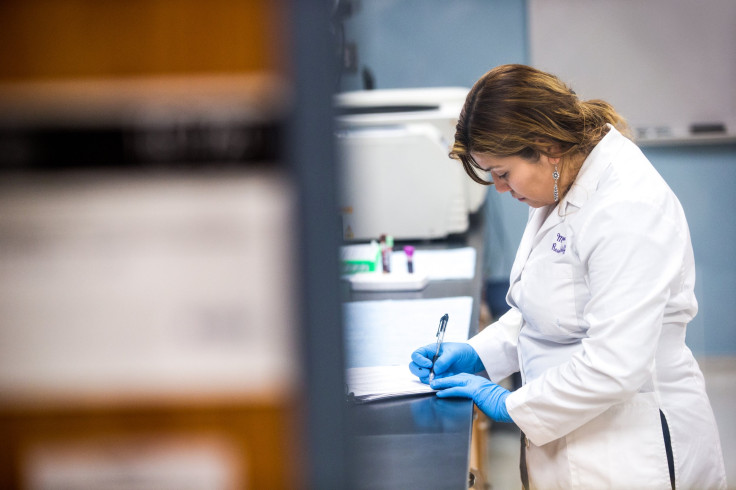The Latest Instrument In A Doctor’s Medical Bag? AI

Cancer, heart disease and diabetes are diseases that will affect each one of us – whether it’s our journey, or a loved one’s.
Despite the tireless work of clinicians and researchers to advance treatment, the World Health Organization still expects a global shortfall of 18 million healthcare workers by 2030 worldwide. Coupled with an aging global population, the strain on the healthcare sector is mounting.
Ensuring our global healthcare systems can address these challenges is a matter that affects all of us and our families.
I believe technologies like artificial intelligence and the cloud have a key part to play in tackling this problem. It’s particularly exciting to see a growing number of breakthroughs that allow clinicians to diagnose diseases more quickly and to shorten the time to devise personalized treatment plans.
New innovations are helping the healthcare industry become more effective, providing people with a greater opportunity to lead longer, healthier lives.
Allow me to share some examples I’ve seen from around the world.
Taking the fight against cancer to the next level
A cancer diagnosis can be devastating. But the shock of receiving the difficult news is only the beginning. Often, patients must then schedule a series of follow up appointments with various healthcare professionals, and the psychological toll for the patient and his or her family can be immense. All they want is the cancer to be treated as quickly as possible – and precious weeks can be lost while a treatment plan is formulated.
MercyAscot Hospital in New Zealand has changed this experience. In moving to the cloud, clinicians and administrators were able to share and access information much more easily. The hospital was then able to deploy a values-based approach to service delivery, which is when doctors are compensated for the services they provide versus the number of patients they see. Now when a patient is diagnosed with an aggressive form of cancer, surgeons, radiologists and pathologists can literally gather in one room, review all pertinent information and devise a treatment plan jointly. The time span from a preliminary diagnosis to receiving a plan has shrunk from eight to 12 weeks to just 45 minutes.
Another organization making advancements in cancer diagnostics and treatment is Toronto’s University Health Network. When I met with the organization earlier this year, I had the opportunity to see first-hand how an AI-powered technology allows clinicians to better predict how certain cancers will react to different therapies. With the Canadian Cancer Society estimating that up to half of Canadians will be diagnosed with cancer in their lifetime, advancements like this will immeasurably benefit the country’s citizens and the wider world.
Addressing the threat of diabetes
Internationally, diabetes affects approximately 415 million people. It’s estimated that as many as 114 million Chinese citizens have the disease — however only 30 percent know it. Left untreated, the disease can lead to blindness, kidney damage and elevate other major health risks. The under diagnoses of diabetes poses a threat to patients and to the country’s health system.
When I was in China earlier this year, I learned of a local startup company called Airdoc, which has developed a diagnostic tool that can instantly detect signs of chronic illnesses including diabetes. How? By simply taking a high-resolution image of the back of the eye. To create it, the Airdoc team used thousands of retinal scans to link retinal abnormalities with specific health issues.
The Airdoc device — which is similar to the scanner optometrists used for routine eye exams — can recognize signs of more than 30 diseases. Eventually, it will be able to diagnose 200. The plan is to make it available in more than 1,000 optical retail stores across China over the next few years, ensuring millions of unsuspecting people can learn how to manage the condition they didn’t know they had, as quickly as possible.
Spotting those at risk for coronary disease
Heart disease is the leading worldwide cause of death. In India, doctors have a unique challenge in terms of identifying those most at risk: most of the healthcare sector’s prediction models for coronary disease risk have been based on European and North American patient populations. For example, high LDL cholesterol, which is a significant cause of heart attacks in western countries, is less common in India.
Apollo Hospitals, one of India’s largest private healthcare companies, is making strides in better spotting patients more vulnerable to cardiac illnesses. Clinicians and data scientists reviewed more than 400,000 of its patient records and, using machine learning, the team identified the 21 risk factors in Indian populations. This innovation means doctors are better equipped to help people before they get very sick. It’s true what they say: prevention is the best cure.
Every healthcare company is becoming a technology company
Beyond improving healthcare providers’ ability to quickly and accurately diagnosis illness, innovation has a critical role to play in all facets of healthcare, from enhancing R&D to empowering patients.
As all healthcare companies become technology companies, we’ll see operational costs go down and the quality of care go up.
I truly believe that the digital transformation of healthcare means a healthier health sector, and more importantly, a healthier world.
(Jean-Philippe Courtois is the executive vice president and president, global sales, marketing & operations, at Microsoft.)
© Copyright IBTimes 2025. All rights reserved.





















